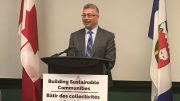Keeping track of all the data surrounding climate change is nearly impossible.
About a year ago, the federal government launched what it hopes is a one-stop shop for Canadians to find climate change information.
It’s called the Canadian Centre for Climate Services, and the northern office recently opened.
Brian Sieben is the contact person for the northern office, which serves all three territories plus Nunavik and Nunatsiavut.
Last week, Sieben gave a north-focused presentation on the service at the Yellowknife Geoscience Forum.
Through partnerships with organizations like the Climate Atlas of Canada and ClimateData.ca, both historical data and future projections are available. Sieben says having both makes it easier for northerners to adapt to climate change.
He added that Indigenous people on the land are the local eyes and ears of climate change.
“They are the climate change experts so I’m really eager to hear from them on what information they need and what they’re seeing,” says Sieben.
He added that the goal was to make the information accessible for everyone from engineers to chiefs and council.
Some of those projections
Based on the data, the North is in for some significant changes—changes that are only a few decades away.
Sieben outlined a few examples. Right now, he said, the typical warmest day in Yellowknife is about 29 degrees Celsius. In 35 years, that could go up to 31 degrees, which will likely mean more forest fires. On the flip side, the average coldest temperatures could jump from -43 degrees to -37 degrees.
“One of the limits of these extreme cold temperatures is that it keeps out invasive species from moving north,” says Sieben. “As we lose that winter killing temperature, we may have to worry about new invasive species or diseases moving north.”
Finally, harvesters are likely to continue to see shorter and shorter seasons with solid ice crossings as the number of days below zero is predicted to drop from the current 175 to 156.
Climate change every day
If you’ve followed the climate conversation at all, you likely know about the Paris Agreement, which aims to keep total warming to between 1.5 and two degrees by 2030. (Spoiler alert, Canada is well away from its emissions targets to make this happen.)
If we zoom in on the North, the average warming has already surpassed those targets, says Sieben, with an average of 2.3 degrees. Some areas are even worse: since the late 1950s, Inuvik’s average air temperature has jumped four degrees—more than four times the average of the rest of the planet.
“There’s no denying that all northerners are very much seeing climate change in their daily lives,” says Sieben. “Everyone has to consider climate change in their day-to-day decisions and its impact on life here.”
You can get in touch with the Canadian Centre for Climate Services at 1-833-517-0376 or info.cccs-ccsc@canada.ca.
Francis was a reporter with CKLB from January 2019 to March 2023. In his time with CKLB, he had the immense pleasure and honour of learning about northern Indigenous cultures.








